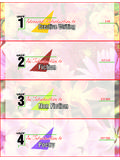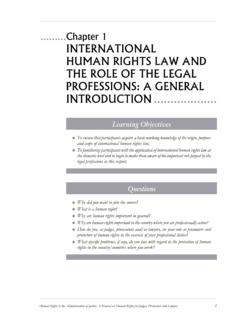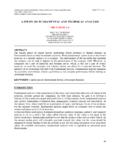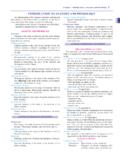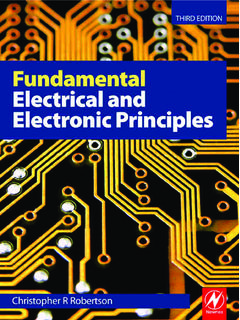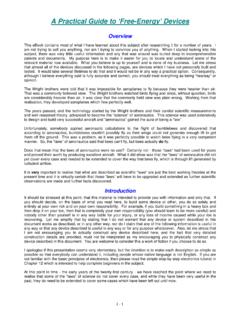Transcription of SYMBOLS, UNITS, NOMENCLATURE AND …
1 INTERNATIONAL UNION OF PURE AND APPLIED PHYSICSC ommission C2 - SUNAMCOSYMBOLS, UNITS, NOMENCLATURE ANDFUNDAMENTAL CONSTANTSIN PHYSICS1987 REVISION (2010 REPRINT)Prepared byE. Richard CohenandPierre Giacomo(SUNAMCO 87-1)PREFACE TO THE 2010 REPRINTThe 1987 revision of the SUNAMCO Red Book has for nearly a quarter of a century providedphysicists with authoritative guidance on the use of symbols , units and NOMENCLATURE . As such, itis cited as a primary reference by the IUPAC Green Book (Quantities, Units and symbols inPhysical Chemistry, 3rd edition, E. R. Cohen et al., RSC Publishing, Cambridge,2007) and theSI Brochure (The International System of Units (SI), 8th edition, BIPM, S`evres, 2006).This electronic version has been prepared from the originalTeX files and reproduces thecontent of the printed version, although there are some minor differences in formatting andlayout.
2 In issuing this version, we recognise that there areareas of physics which have cometo prominence over the last two decades which are not coveredand also that some materialhas been superseded. In particular, the values of the fundamental constants presented insection 6 have been superseded by more recent recommended values from the CODATA TaskGroup on Fundamental Constants. The currently recommendedvalues can be obtained SUNAMCO has established a Committee for Revision of theRed Book. Suggestions for material to be included in a revised version can be directed to theSUNAMCO Secretary at of the 1987 printed version are available on application to the IUPAP Secretariat,c/o Insitute of Physics, 76 Portland Place, London W1B 1NT, United Kingdom, J.
3 Mohr, ChairStephen N. Lea, SecretaryIUPAP Commission C2 - SUNAMCOUNION INTERNATIONALE DEINTERNATIONAL UNION OFPHYSIQUE PURE ET APPLIQU EEPURE AND APPLIED PHYSICSC ommission SUNAMCOSUNAMCO CommissionSYMBOLS, UNITS, NOMENCLATURE ANDFUNDAMENTAL CONSTANTSIN PHYSICS1987 REVISIONP repared byE. Richard CohenRockwell International Science CenterThousand Oaks, California, USAandPierre GiacomoBureau International des Poids et MesuresS`evres, FranceDocument (SUNAMCO 87-1)UNION INTERNATIONALE DEINTERNATIONAL UNION OFPHYSIQUE PURE ET APPLIQU EEPURE AND APPLIED PHYSICSC ommission SUNAMCOSUNAMCO CommissionPRESIDENT (1984-1987)D. Allan BromleyWright Nuclear Structure Laboratory272 Whitney AvenueNew Haven, CT 06511, USAPRESIDENT (1987-1990)Larkin KerwinPhysics DepartmentUniversit e LavalQuebec, PQ G1K 7P4, CANADASECRETARY-GENERALJan S.
4 NilssonInstitute of Theoretical PhysicsChalmers Institute of TechnologyS-412 96 G oteborg, SWEDENASSOCIATE SECRETARY-GENERALJohn R. KlauderAT&T Bell Laboratories600 Mountain AvenueMurray Hill, NJ 07974, USAR eprinted fromPHYSICA 146A (1987) 1-68 PRINTED IN THE NETHERLANDSINTRODUCTIONThe recommendations in this document, compiled by the Commission forSymbols, Units, NOMENCLATURE , Atomic Masses and Fundamental Constants(SUN/AMCO Commission) of the International Union of Pure and AppliedPhysics (IUPAP), have been approved by the successive General Assemblies ofthe IUPAP held from 1948 to recommendations are in general agreement with recommendations ofthe following international organizations:(1) International Organization for Standardization, Technical Committee ISO/TC12(2) General Conference on Weights and Measures (1948 1983)(3) International Union of Pure and Applied Chemistry (IUPAC)(4) International Electrotechnical Commission, Technical Committee IEC/TC25(5) International Commission on document replaces the previous recommendations of theSUNC ommission published under the titleSymbols, Units and NOMENCLATURE inPhysicsin 1961 (UIP-9, [SUN 61-44]), 1965 (UIP-11, [SUN 65-3]) and 1978(UIP-20, [SUN 78-5], Physica93A(1978) 1 63).
5 Robert C. Barber, Chairman IUPAP Commission 2 International Union of Pure and Applied PhysicsCommission on symbols , Units, NOMENCLATURE ,Atomic Masses and Fundamental ConstantsChairman, R. C. Barber (Canada); Secretary, P. Giacomo (France)Members (1981 1987): K. Birkeland (Norway), W. R. Blevin (Australia),E. R. Cohen (USA), V. I. Goldansky (USSR, Chairman, 1981 1984),E. Ingelstam (Sweden), H. H. Jensen (Denmark), M. Morimura (Japan),B. W. Petley (UK), E. Roeckl (Fed. Rep. Germany), A. Sacconi (Italy),A. H. Wapstra (The Netherlands), N. Zeldes (Israel).iiCONTENTSPREFACE .. v1 GENERAL RECOMMENDATIONS .. Physical NOMENCLATURE for intensive Dimensional and dimensionless ratios82 symbols FOR ELEMENTS, PARTICLES, STATES ANDTRANSITIONS .. Chemical Nuclear Fundamental Spectroscopic NOMENCLATURE conventions in nuclear physics153 DEFINITION OF UNITS AND SYSTEMS OF UNITS.
6 Systems of The International System of Units (SI) Non-SI units of special interest in physics214 RECOMMENDED symbols FOR PHYSICAL QUANTITIES .. Space and Statistical Electricity and Radiation and Quantum Atomic and nuclear Molecular Solid state Chemical Plasma Dimensionless parameters44iiiiv5 RECOMMENDED MATHEMATICAL symbols .. General Letter Complex Vector Matrix Symbolic Theory of symbols for special values of periodic quantities516 RECOMMENDED VALUES OF THE FUNDAMENTALPHYSICAL CONSTANTS .. 52 APPENDIX. NON-SI SYSTEMS OF QUANTITIES AND UNITS .. Systems of equations with three base Systems of equations with four base Relations between quantities in different The CGS system of Atomic units66 PREFACET here are two broad classes of dictionaries: those that are proscriptive andattempt to establish the norms of a language and those that are descriptiveand report the language as it is used.
7 For dictionaries of a living language,both types have their place. A manual of usage in science howevermust be primarily descriptive and should reflect the standards of practicethat are current in the field and should attempt to impose a standardonly in those cases where no accepted standards exist. This revision ofthe handbook has taken these precepts into account while expanding thediscussion of some topics and correcting typographical errors of the 1978edition. There has been some reordering of the material withthe hope thatthe new arrangement will improve the logical flow, but, sincephysics is notone-dimensional, that goal may be recommended symbols in section4, particularly those related tophysical chemistry, have been actively coordinated with the correspondingrecommendations of Commission on symbols , Units and Terminology ofIUPAC in order to avoid any conflict between the two.
8 The values of thephysical constants given in section6are drawn from the 1986 adjustmentby the CODATA Task Group on Fundamental Richard CohenThousand OaksPierre GiacomoS`evresJuly, 1987v1 GENERAL RECOMMENDATIONS* Physical quantitiesThere are two somewhat different meanings of the term physical quantity .One refers to the abstract metrological concept ( , length, mass, temperature),the other to a specific example of that concept (an attribute of a specific objector system: diameter of a steel cylinder, mass of the proton, critical temperatureof water). Sometimes it is important to distinguish betweenthe two and, ideally,it might be useful to be able to do so in all instances. Howeverlittle is tobe gained by attempting to make that distinction in this report.
9 The primaryconcern here is with symbols and terminology in general; section6, however,gives the symbols and numerical values of specific physical DefinitionsA physical quantity**is expressed as the product of a numerical value ( , apure number) and a unit :physical quantity = numerical value unit :For a physical quantity symbolized bya, this relationship is represented in theforma={a} [a];where{a}stands for the numerical value ofaand [a] stands for the unit ofa. Neither the name nor the symbol for a physical quantity should imply anyparticular choice of physical quantities combine by multiplication or division the usual rulesof arithmetic apply to both the numerical values and to the units. A quantitywhich arises (or may be considered to arise) from dividing one physical quantityby another with the same dimension has a unit which may be symbolized by thenumber 1; such a unit often has no special name or symbol and the quantity isexpressed as a pure :E= 200 JF= 27 N/m2n= 1:55 (refractive index)f= 3 108Hz* For further details see International Standard ISO 31/0-1981 :General PrinciplesConcerning Quantities, Units and symbols .
10 ** French:grandeur physique; German:physikalische Gr osse; Italian:grandezza fisica;Russian:fizicheskaya velichina; Spanish:magnitud f SymbolsSymbols for physical quantities should be single letters ofthe Latin or Greekalphabet with or without modifying signs (subscripts, superscripts, primes,etc.). The two-letter symbols used to represent dimensionless combinations ofphysical quantities are an exception to this rule (see Dimensionlessparameters ). When such a two-letter symbol appears as a factor in a productit should be separated from the other symbols by a dot, by a space, or byparentheses. It is treated as a single symbol and can be raised to a positive ornegative power without using ( , shortened forms of names or expressions, such as forpartition function) may be used in text, but should not be used in physicalequations.
